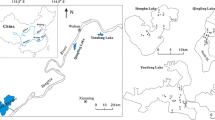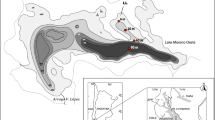Abstract
Spatial heterogeneity of benthic communities has clear implications for estimating lake production, biodiversity as well as identifying representative sites for palaeolimnological studies. This study investigates chironomid variability and the controlling factors (i.e., environmental and spatial variables) in surface sediments from Taihu Lake (2,338 km2), a hypertrophic lake in the Yangtze delta in eastern China. The spatial distribution of chironomids shows distinct heterogeneity. Microchironomus tabarui-type and Tanypus dominate the midge communities around the estuaries, while Cricotopus sylvestris-type and Polypedilum nubifer-type are the predominant taxa in the East Bays and the East Taihu Lake. Redundancy analysis was used for exploring the relationships between chironomid variability and environmental and spatial stressors. Four variables were identified as significant factors that influence chironomid community structures. The high nutrient concentrations around the estuarial areas favor the development of nutrient-tolerant taxa. Water depth-related oxygen depletion in the open lake during algae blooms prohibits the survival of many organisms, except for a few hypoxic-resistant species. High transparency in the East Bays and the East Taihu Lake indirectly creates a favorite microhabitat for macrophyte-associated chironomid species through aquatic plants. Space per se is a significant forcing factor for organism community and distribution at scales of >1,000 km2. It might be important to consider spatial variables more explicitly in future studies of chironomids in large lakes where multiple stressors make the interactions within the ecosystem more complicated. This study aims to illustrate the ecological characteristics of specific chironomid taxa related to a “microecosystem” which is contributed by the multiple environmental gradients within a large lake, and to provide empirical support for interpretation of palaeochironomid data.






Similar content being viewed by others
References
Berg, C. O., 1950. Biology of certain Chironomidae reared from Potamogeton. Ecological Monographs 20: 83–101.
Borcard, D. & P. Legendre, 2004. SpaceMaker2 – user’s guide. Département de sciences biologiques, Université de Montréal.
Brodersen, K. P., B. V. Odgaard, O. Vestergaard & N. J. Anderson, 2001. Chironomid stratigraphy in the shallow and eutrophic Lake Søbygaard, Denmark: chironomid–macrophyte co-occurrence. Freshwater Biology 46: 253–267.
Brooks, S. J., H. Bennion & H. J. B. Birks, 2001. Tracing lake trophic history with a chironomid-total phosphorus inference model. Freshwater Biology 46: 513–533.
Brooks, S. J., P. G. Langdon & O. Heiri, 2007. The identification and use of Palaearctic Chironomidae larvae in palaeoecology. QRA Technical Guide No. 10, Quaternary Research Association, London.
Cai, Y. J., Z. J. Gong & B. Q. Qin, 2010. Community structure and diversity of macrozoobenthos in Lake Taihu, a large shallow eutrophic lake in China. Biodiversity Science 18: 50–59. (abstract in English).
Eggermont, H., P. D. Deyne & D. Verschuren, 2007. Spatial variability of chironomid death assemblages in the surface sediments of a fluctuating tropical lake (Lake Naivasha, Kenya). Journal of Paleolimnology 38: 309–328.
Engels, S. & L. C. Cwynar, 2011. Changes in fossil chironomid remains along a depth gradient: evidence for common faunal thresholds within lakes. Hydrobiologia 665: 15–38.
Fortin, M. J. & M. R. T. Dale, 2005. Spatial analysis: a guide for ecologists. Cambridge University Press, Cambridge.
Frey, D. G., 1988. Littoral and offshore communities of diatoms, cladocerans, and dipterous larvae, and their interpretation in paleolimnology. Journal of Paleolimnology 1: 179–191.
Gong, Z. J., P. Xie, H. J. Tang & S. D. Wang, 2001. The influence of eutrophication upon community structure and biodiversity of macrozoobenthos. Acta Hydrobiologica Sinica 25: 210–216. (abstract in English).
Grodhaus, G., 1963. Chironomid midges as a nuisance II, the nature of the nuisance and remarks on its control. California Vetor Views 10: 27–37.
Gu, X. H., S. Z. Zhang, X. L. Bai, W. P. Hu, Y. H. Hu & X. R. Wang, 2005. Evolution of community structure of aquatic macrophytes in East Taihu Lake and its wetlands. Acta Ecologica Sinica 25: 1541–1548. (abstract in English).
Hall, R. I., P. R. Leavitt, R. Quinlan, A. S. Dixit & J. P. Smol, 1999. Effects of agriculture, urbanization, and climate on water quality in the northern Great Plains. Limnology and Oceanography 44: 739–756.
Jin, X. C. & Q. Y. Tu, 1990. The Standard Methods for Observation and Analysis of Lake Eutrophication, 2nd ed. China Environmental Science Press, Beijing. (in Chinese).
Korhola, A., 1999. Distribution patterns of Cladocera in subarctic Fennoscandian lakes and their potential in environmental reconstruction. Ecography 22: 357–373.
Korhola, A., H. Olander & T. Blom, 2000. Cladocera and chironomid assemblages as quantitative indicators of water depth in subarctic Fennoscandian lakes. Journal of Paleolimnology 24: 43–54.
Langdon, P. G., Z. Ruiz, K. P. Brodensen & I. D. L. Foster, 2006. Assessing lake eutrophication using chironomids: understanding the nature of community response in different lake types. Freshwater Biology 51: 562–577.
Langdon, P. G., Z. Ruiz, S. Wynne, C. D. Sayer & T. A. Davidson, 2010. Ecological influences on larval chironomid communities in shallow lakes: implications for palaeolimnological interpretations. Freshwater Biology 55: 531–545.
Larocque, I., 2001. How many chironomid head capsules are enough? A statistical approach to determine sample size for palaeoclimatic reconstructions. Palaeogeography, Palaeoclimatology, Palaeoecology 172: 133–142.
Larocque, I., R. Pienitz & N. Rolland, 2006. Factors influencing the distribution of chironomids in lakes distributed along a latitudinal gradient in northwestern Quebec, Canada. Canadian Journal of Fisheries and Aquatic Science 63: 1286–1297.
Legendre, P., 1993. Spatial autocorrelation: trouble or new paradigm. Ecology 74: 1956–1973.
Little, J. L. & J. P. Smol, 2000. Changes in fossil midge (Chironomidae) assemblages in response to cultural activities in a shallow, polymictic lake. Journal of Paleolimnology 23: 207–212.
McCullagh, P. & J. A. Nelder, 1989. Generalized Linear Models. Chapman and Hall, London.
Mehner, T., F. Holker & P. Kasprzak, 2005. Spatial and temporal heterogeneity of trophic variables in a deep lake as reflected by repeated singular samplings. Oikos 108: 401–409.
Middelboe, A. L. & S. Markager, 1997. Depth limits and minimum light requirements of freshwater macrophytes. Freshwater Biology 37: 553–568.
Oertli, B. & J. Lachavanne, 1995. The effects of shoot age on colonization of an emergent macrophyte (Typha latifolia) by macroinvertebrates. Freshwater Biology 34: 421–431.
Olander, H., A. Korhola & T. Blom, 1997. Surface sediment Chironomidae (Diptera) distribution along an ecotonal transect in subarctic Fennoscandia: developing a tool for palaeotemperature reconstructions. Journal of Paleolimnology 18: 45–59.
Oliver, D. R. & M. E. Roussel, 1983. The Insects and Arachnids of Canada. Part II: The Genera of Larval Midges of Canada. Diptera: Chironomidae. Agriculture Canada Publication 1746: 263.
Qin, B. Q., 2008. Lake Taihu, China: Dynamics and Environmental Changes. Springer, Dordrecht.
Qin, B. Q., W. P. Hu & W. M. Chen, 2004. The Processes and Mechanism of Lake Taihu Environmental. Science Press, Beijing. (in Chinese).
Qin, B. Q., G. W. Zhu, G. Gao, Y. L. Zhang, W. Li, H. W. Paerl & W. W. Carmichael, 2010. A drinking water crisis in Lake Taihu, China: linkage to climatic variability and lake management. Environmental Management 45: 105–112.
Quinlan, R. & J. P. Smol, 2001. Chironomid-based inference models for estimating end-of-summer hypolimnetic oxygen from south-central Ontario shield lakes. Freshwater Biology 46: 1529–1551.
Quinlan, R., A. M. Paterson, R. I. Hall, P. J. Dillon, A. N. Wilkinson, B. F. Cumming, M. S. V. Douglas & J. P. Smol, 2003. A landscape approach to examining spatial patterns of limnological variables and long-term environmental change in a southern Canadian lake district. Freshwater Biology 48: 1676–1697.
Rieradevall, M. & S. J. Brooks, 2001. An identification guide to subfossil Tanypodinae larvae (Insecta: Diptera: Chironomidae) based on cephalic setation. Journal of Paleolimnology 25: 81–99.
Ruiz, Z., A. G. Brown & P. G. Langdon, 2006. The potential of chironomid (Insecta: Diptera) larvae in archaeological investigations of floodplain and lake settlements. Journal of Archaeological Science 33: 14–33.
Smock, L. A. & D. L. Stoneburner, 1980. The response of macroinvertebrates to aquatic macrophyte decomposition. Oikos 35: 397–403.
Sun, S. C. & Y. P. Huang, 1993. Taihu Lake. China Ocean Press, Beijing. (in Chinese).
Sweetman, J. & J. Smol, 2006. Patterns in the distribution of cladocerans (Crustacea, Branchiopoda) in lakes across a north-south transect in Alaska, USA. Hydrobiologia 553: 277–291.
ter Braak, C. J. F. & I. C. Prentice, 1988. A theory of gradient analysis. Advances in Ecological Research 18: 271–317.
ter Braak, C. J. F. & P. Šmilauer, 2002. CANOCO reference manual and CanoDraw for Windows user’s guide: software for canonical community ordination (version 4.5). Microcomputer Power, Ithaca.
Tilman, D. & P. Kareiva, 1997. The role of space in population dynamics and interspecific interactions. Princeton University Press, Princeton.
Vestergaard, O. & K. Sand-Jensen, 2000. Aquatic macrophyte richness in Danish lakes in relation to alkalinity, transparency, and lake area. Canadian Journal of Fisheries and Aquatic Sciences 57: 2022–2031.
Walker, I. R., C. H. Fernando & C. G. Paterson, 1984. The chironomid fauna of four shallow, humic lakes and their representation by subfossil assemblages in the surficial sediments. Hydrobiologia 112: 61–67.
Weatherhead, M. A. & M. R. James, 2001. Distribution of macroinvertebrates in relation to physical and biological variables in the littoral zone of nine New Zealand lakes. Hydrobiologia 462: 115–129.
Wiederholm, T., 1983. Chironomidae of the Holarctic Region. Keys and diagnoses. Part I. Larvae. Entomologica Scandinavica Supplement: 457.
Wiederholm, T. & L. Eriksson, 1979. Subfossil chironomids as evidence of eutrophication in Ekoln Bay, central Sweden. Hydrobiologia 62: 195–208.
Xiong, F., W. C. Li & J. Z. Pan, 2007. Spatial distribution of chironomid larvae and its environmental analysis in Lake Fuxian, Yunnan Province. Chinese Journal of Applied Ecology 18: 179–184. (abstract in English).
Xu, P. Z. & B. Q. Qin, 2005. Water quantity and pollutant fluxes of the surrounding rivers of Lake Taihu during the hydrological year of 2001–2002. Journal of Lake Sciences 17: 213–218. (abstract in English).
Yang, H., R. J. Flower & R. W. Battarbee, 2009. Influence of environmental and spatial variables on the distribution of surface sediment diatoms in an upland loch, Scotland. Acta Botanica Croatica 68: 367–380.
Yang, X. D., N. J. Anderson, X. H. Dong & J. Shen, 2008. Surface sediment diatom assemblages and epilimnetic total phosphrous in large, shallow lakes of the Yangtze floodplain: their relationships and implications for assessing long-term eutrophication. Freshwater Biology 53: 1273–1290.
Zhang, E. L., A. Bedford, R. Jones, J. Shen, S. M. Wang & H. Q. Tang, 2006. A subfossil chironomid-total phosphorus inference model for lakes in the middle and lower reaches of Yangtze River. Chinese Science Bulletin 51: 2125–2132.
Zhao, L. L., M. Y. Zhu, L. Q. Feng, X. H. Liu, G. W. Zhu, Y. F. Chen & B. Q. Qin, 2011. Stratification and its driving factors of water physicochemical variables in large, shallow Lake Taihu. Journal of Lake Sciences 23: 649–656. (abstract in English).
Acknowledgments
This study was supported by the National Basic Research Program of China (No: 2008CB418103, 2012CB956100), the Knowledge Innovation Program of the Chinese Academy of Sciences (kzcx2-yw-319) and National Natural Science Foundation of China (41072267). We thank Dr. Yunlin Zhang and Dr. Xuhui Dong for their help on the preparation of this manuscript, and two anonymous referees for comments which helped improve the manuscript.
Author information
Authors and Affiliations
Corresponding author
Additional information
Handling editor: Jasmine Saros
Rights and permissions
About this article
Cite this article
Cao, Y., Zhang, E., Chen, X. et al. Spatial distribution of subfossil Chironomidae in surface sediments of a large, shallow and hypertrophic lake (Taihu, SE China). Hydrobiologia 691, 59–70 (2012). https://doi.org/10.1007/s10750-012-1030-3
Received:
Revised:
Accepted:
Published:
Issue Date:
DOI: https://doi.org/10.1007/s10750-012-1030-3




